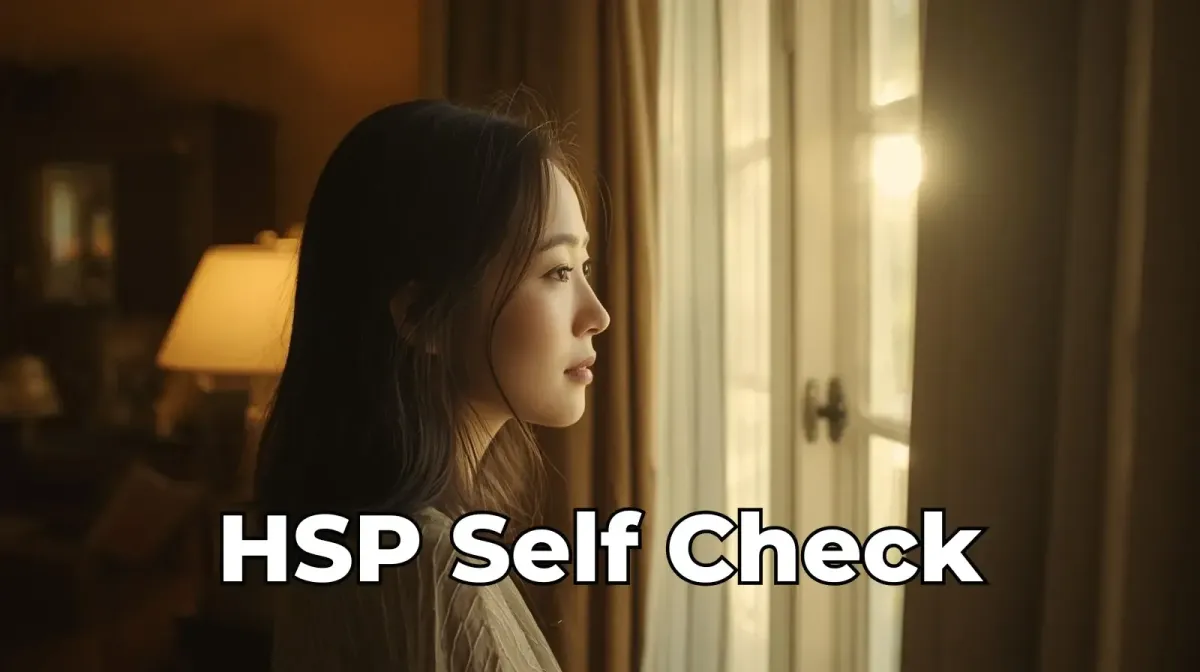Peter Paul Parker's Official Website
Articles And Guidance

HSP-12: A Gentle Self-Check (UK)
This is a gentle, non-diagnostic HSP self-check to help you understand your sensitivity patterns and choose kinder supports. It takes three minutes. You’ll rate 12 everyday statements, tot up a simple score, and get body-first next steps, plus UK-specific tips for home and work. If you’re new to this topic, start with the bigger map here: What Is a Highly Sensitive Person?
A kind note before we begin
This tool is educational, not a diagnosis. Sensitivity overlaps with other experiences (e.g., trauma history, ADHD/autism, anxiety). Use this as information, not a label. If any step increases distress, pause, simplify, and come back later.
Companions you can keep open in tabs:
Window of Tolerance: HSP Quick Map
2-Minute Body Resets for HSPs
How to use the HSP-12
Read each statement. Circle/note how often it’s true this month:
0 = rarely
1 = sometimes
2 = often
3 = very often
Add your total (0–36). Then see the gentle guidance below.
Interpreting your total (kind ranges):
0–12 — Your sensitivity shows up sometimes. You may need supports only in busy seasons.
13–24 — You’re mid-range. Daily micro-supports can help you thrive and avoid overwhelm.
25–36 — You’re highly sensitive. Build steady routines, boundaries, and co-regulation early.
This is not a pass/fail. Your number simply helps you choose the right-sized supports.
You can use the app below, or there are written out questions for you to answer underneath the app if you prefer to take this test using a pen and paper. All your answers are private and are not recorded. You also have the option to start a free Meraki guide online journal to keep your answers all together with your journal that is stored on your computer. It is 100% private to you.
The HSP-12 statements (this month)
I feel overstimulated by noise, light, or busy spaces. (0–3)
I notice subtle changes (tone, temperature, people’s moods). (0–3)
I process things deeply and need time before responding. (0–3)
I pick up others’ emotions and can feel drained without boundaries. (0–3)
I’m moved by art, music, or nature more than most people. (0–3)
I startle or fatigue easily when life is full. (0–3)
I need downtime after social/work events, even the good ones. (0–3)
Caffeine, hunger, or poor sleep affect me strongly. (0–3)
I avoid conflict or over-explain to keep the peace. (0–3)
I carry old hurts; certain tones or looks trigger me. (0–3)
I feel guilty saying no and over-commit. (0–3)
I flourish with steady routines (light, movement, sleep, quiet). (0–3)
Add them up. Take a breath. Whatever your score, we go kind and small.
Helpful companions while you reflect:
Self-Compassion for HSPs: Soften Shame, Build Inner Safety
Overwhelm Recovery Routines for HSPs
Your next steps (by range)
If you scored 0–12
You’re sensitive at times. Keep a simple “baseline kit” so busy seasons don’t tip you:
Morning anchor (5–10 mins): light stretch + three slow breaths.
Afternoon reset (2 mins): sip water, look out of a window, exhale longer.
Evening wind-down: lamps on, screens down, same time nightly.
Starter supports:
Morning Rituals for HSPs: Start Calm
Sleep for Emotional Healing (HSP Edition)
If you scored 13–24
You’re mid-range sensitive. Small daily supports will change the game:
Breath at ~0.1 Hz (5 mins) in the morning.
Capacity cue at work/home: “I’m at capacity; back in 15.”
Two-option choices to reduce decision fatigue (walk or stretch?).
Core how-tos:
HRV Breathing (0.1 Hz): Starter Guide
Polyvagal Basics for Sensitive People
If you scored 25–36
You’re highly sensitive and likely deep-processing. Build a steady scaffold:
Morning: 10–12 minutes (breath + gentle movement + plan one kind win).
Daytime: 2-minute resets after meals; quiet work blocks; limit high-stim input.
Evening: predictable wind-down; warm light; earlier screen-off.
Boundaries: one “not today” daily; one clear ask per week.
Scaffold pieces:
Boundaries for HSPs: Warm, Clear, Kind
2-Minute Body Resets for HSPs
Your personal pattern map (read your top items)
Look at the three highest statements you circled. Use these tiny, targeted swaps:
If 1/6/8 were high (sensory/physiology): reduce glare, add breaks, steady meals, earlier light-down.
If 3/12 were high (deep processing/need routines): protect quiet thinking time; calendar your anchors.
If 4/9/11 were high (empathy/people-pleasing): practise one boundary script a day.
If 5 was high (aesthetic sensitivity): add daily beauty—music, trees, poem, gallery image.
If 10 was high (old hurts): consider tiny, safe shadow-work glances with strong stop points.
Gentle guides:
People-Pleasing and Boundaries
Shadow Work Safety: Tiny Steps That Work
Shadow Work and Journaling: Writing Prompts for Self-Discovery
A 7-day micro-plan (repeat weekly)
Day 1 — Morning anchor
Three slow breaths, shoulder rolls, choose one kind win.
Day 2 — Capacity cue
Tell someone: “I’m at capacity; back in 15.” Practise once.
Day 3 — Light + movement
Daylight in your eyes before screens; 10-minute walk or gentle Qi Gong.
Qi Gong for Emotional Healing: Move, Breathe, Release
Day 4 — Two-option choices
Reduce decision fatigue: “walk or stretch,” “email or tea first.”
Day 5 — Boundary script
One clear, kind “no for now.”
Boundaries for HSPs: Warm, Clear, Kind
Day 6 — Co-regulation
Walk-and-talk with a safe person; no fixing, just company.
Spiritual Loneliness: Find Support When You’re Lost
Day 7 — Review
Keep one thing that helped; remove one friction. Early lights-down.
Sleep and reset helpers:
Sleep for Emotional Healing (HSP Edition)
Overwhelm Recovery Routines for HSPs
UK workplace notes (practical and kind)
You can ask for reasonable adjustments to support focus and wellbeing, even without a formal diagnosis. Make requests specific and time-bound with a review date:
Environment: quieter seating, soft lighting, fewer notifications.
Time: two 90-minute focus blocks, one meeting-light morning.
Communication: agenda before meetings; written follow-ups.
Hybrid rhythm: one home-working day for deep work, if the role allows.
Scripts to try:
“Open-plan noise and constant pings reduce my productivity. Could we trial two 90-minute focus blocks daily and one meeting-light morning for two weeks? I’ll report outcomes next Friday.”
Work companions:
Thriving at Work as a Highly Sensitive Person
Nervous-System Support for Highly Sensitive People
Shadow-work safety (if item 10 was high)
Old hurts can flare when you slow down. Keep the resource → glance → return loop tiny:
Resource (60–90s): feet on floor; hand on heart; three slow breaths.
Glance (30–60s): one sentence in your journal about a mild theme.
Return (60–90s): look around, longer exhale, warm drink.
If distress spikes, stop and prioritise sleep, light, movement, safe connection.
Companions:
Shadow Work Safety: Tiny Steps That Work
Self-Compassion for HSPs: Soften Shame, Build Inner Safety
If your score changes month to month
That’s normal. Sensitivity expresses relationally—sleep, seasons, hormones, workload, food, light, and life events all matter. Re-take the HSP-12 at the start of each month. Track one simple metric alongside it (e.g., “mornings calm 0–10”). Adjust your supports kindly.
When you feel spiritually wobbly, these help:
Spiritual Challenges for Highly Sensitive People
Reconnect Intuition When Guidance Runs Dry
When to seek more support (UK routes)
Consider your GP or NHS Talking Therapies (England) if you notice:
Persistent low mood, anxiety, or sleep disruption.
Daily functioning dropping (work, study, caregiving).
Escalating overwhelm, panic, or shutdown.
While you wait: reduce inputs, keep warm light in the evening, add gentle breath and short walks, and reach out to a safe person.
Restore steadiness while you wait:
Morning Rituals for HSPs: Start Calm
2-Minute Body Resets for HSPs
Sleep for Emotional Healing (HSP Edition)
FAQs
Isn’t sensitivity just anxiety?
Not always. Sensitivity includes deep processing, strong empathy, and rich perception. Anxiety can co-occur, but many sensitive people feel calm when they have the right supports.
What Is a Highly Sensitive Person?
Can I be sensitive and still lead teams or parent?
Absolutely. Sensitivity can sharpen ethics, foresight, and care. The key is inputs → boundaries → recovery.
Further reading:
Healthy Relationships as a Highly Sensitive Person
What if I scored high and feel ashamed?
Shame is common and softens with compassion and tiny wins. Start with one warm boundary and one daily reset.
Self-Compassion for HSPs: Soften Shame, Build Inner Safety
Could my score reflect old trauma?
Possibly. Keep practices tiny and body-first. If old pain keeps flaring, ask your GP about trauma-informed support.
Healing Childhood Wounds as a Highly Sensitive Person
Can I change my sensitivity?
You can’t change your wiring, but you can transform your experience by changing environment, routines, boundaries, and self-talk.
Building Emotional Resilience as a Highly Sensitive Person
Next steps
You don’t have to do this alone. If spiritual overwhelm keeps knocking you out of your window—or you feel lost between big openings and everyday life—these two gentle paths give you practical support for exactly what we’ve covered:
Free Soul Reconnection Call — A calm, one-to-one space to settle your system, set spiritual boundaries, and design tiny, repeatable rituals so your practice feels safe, embodied and sustainable.
Dream Method Pathway — A self-paced, 5-step map (Discover → Realise → Embrace → Actualise → Master) to heal old loops, build daily regulation, and integrate spirituality into a stable, meaningful life.

Choose the route that feels kindest today. Both are designed to help highly sensitive people grow spiritually with steadiness and self-trust—gently, steadily, and for real change.
I look forward to connecting with you in my next post.
Until then, be well and keep shining.
Peter. :)
Feeling Spiritually Lost? 🢂
Copyright Peter Paul Parker 2023 <<< ✺✺✺✺✺✺✺✺✺✺✺✺✺✺✺✺✺✺✺✺✺ >>> Terms And Conditions - >>> Privacy - Linked In - YouTube - Facebook -
